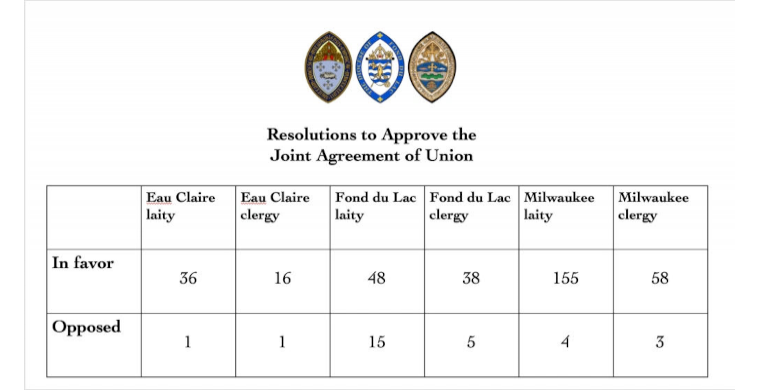BIG CHANGES PLANNED FOR EPISCOPAL DIOCESES IN WISCONSIN
Three smaller dioceses are to become a single statewide diocese
By Mary Ann Mueller
VOL Special Correspondent
www.virtueonline.org
May 7, 2024
The defunct Diocese of Wisconsin is one step away from being reconstituted.
On May 4 the existing Episcopal dioceses of Milwaukee, Fond du Lac and Eau Claire jointly met at a special convention in Baraboo, Wisconsin to vote themselves out of existence; the first step in being united together into the Episcopal Diocese of Wisconsin. The next step is for June's upcoming General Convention, in Louisville, Kentucky, to sign off on the deal.
The May 4 vote to pursue this course of action was: Milwaukee 155/4 in the lay order and 58/3 in the clerical order; Fond du Lac 48/15 in the lay order and 38/5 in the clerical order; Eau Claire 36/1 in the lay order and 16/1 in the clerical order. The proposal passed handily.
The former Diocese of Wisconsin roots run through Nashotah House. The historic diocese initially came into existence in 1847, one year before Wisconsin's statehood, through the work of the much beloved Bishop Jackson Kemper (I Wisconsin) who was the founding force behind the establishment of the famed Anglo-Catholic seminary in Southern Wisconsin. Nashotah was founded in 1842.
Jackson Kemper was ordained first deacon and priest then consecrated missionary bishop by the Presiding Bishop William White. He was both the first and forth Presiding Bishop of the Episcopal Church.
In 1835 Bishop Kemper was sent by mandate of General Convention to the Northwest Territory of the Ohio River which includes the present-day states of Michigan, Wisconsin, Illinois, Ohio, and Indiana to bring the Gospel to the various Indian tribes in that region.
In 1847 the Diocese of Wisconsin was developed and recognized by General Convention with the See City being Milwaukee which was the largest city in Wisconsin and closest to Nashotah House.
Then in 1874 the eastern Fond du Lac Deanery was elevated to diocesan status. It was carved out of the larger Diocese of Wisconsin. And in 1888 the Diocese of Wisconsin was renamed the Diocese of Milwaukee.
In 1928 the western Diocese of Eau Claire was sliced from both the dioceses of Milwaukee and Fond du Lac.
As with other Episcopal dioceses around the United States the three Wisconsin dioceses lost massive membership following the turn of the millennium. It became apparent that for the dioceses to survive they would have to join forces and become a single statewide jurisdiction.
The tri-diocesan effort towards redeveloping the Diocese of Wisconsin began in earnest in 2021. A joint standing committee was formed which then developed seven task forces to examine more closely the statewide unification process. This was called the Collaborative Process Trialogue
The task forces looked at various aspects of a unified life together. The focuses were: (1) Develop and implement systems to foster the sharing of information and conversation; (2) Develop governing documents reflecting proposals developed through task force work; (3) Assess the culture of who we have been, who we are, and who we want to be as congregations, dioceses, Episcopalians and Wisconsinites; (4) Examine the fiscal assets and liabilities for doing mission work if there were one Wisconsin diocese; (5) Organize conversation in and between congregations and dioceses around the work of the task forces; (6).Organize prayer and prepare resources for those praying for discernment about reunification; and (7) Consider questions related to how one diocese may organize or structure itself to maximize the arrangement for the sake of the mission of the church and assuring each congregation received attention and support.
Eau Claire is the weakest diocese in the state. In 2022 there were 19 parishes, 970 members, with an Average Weekly Attendance (AWA) of 380. There were seven baptisms, one wedding, no confirmations and no receptions. The Plate & Pledge was $1,815,540.
In 2022 Fond du Lac had 32 parishes, 3,500 members, with an AWA of 1,162. There were 33 baptisms, 31 confirmations, 15 weddings and 17 received. The Plate & Pledge was $3,520,632.
Obviously, Milwaukee is the strongest diocese. In 2022 it had 48 parishes, 6,401 members and an AWA of 2,051. There were 74 baptisms, 54 confirmations, 33 weddings, and 50 received. The Plate & Pledge was million $7,836,716.
When the proposed Diocese of Wisconsin is re-created, it will encompass the entire state. When that happens the Diocese of Wisconsin will join 21 other dioceses in which diocesan borders and state lines match including: Connecticut, Maine, Vermont, Rhode Island, New Hampshire, West Virginia, Mississippi, Delaware, Wyoming, Montana, Colorado, Iowa, Minnesota, North Dakota, South Dakota, Nebraska, Oklahoma, Alaska, Hawaii, Arkansas, and Nevada.
Most recently The Episcopal Diocese of Fond du Lac was gifted with $7.9 million from the Sisterhood of the Holy Nativity.
The once thriving Wisconsin-based Religious Order was founded in 1882. The Sisterhood is now down to two living but aging Sisters and as part of their end-of-life estate planning for their dwindling Religious Order, they gifted their home diocese with the money. Bishop Matthew Gunter (VIII Fond du Lac) is the Sisters' Episcopal Visitor.
Bishop Gunter is also the bishop provisional for Eau Claire and Bishop assisting for Milwaukee. When the ink is dry on the Diocese of Wisconsin's paperwork Bishop Gunter will be the new Diocese's bishop ordinary.
The Sisters earmarked $1 million for theological education; the rest goes for congregational development.
The Sisterhood's $7.9 million giftedness is timely and will certainly help as the historic Diocese of Wisconsin comes back into being.
Mary Ann Mueller is a journalist living in Texas. She is a regular contributor to Virtue Online.














